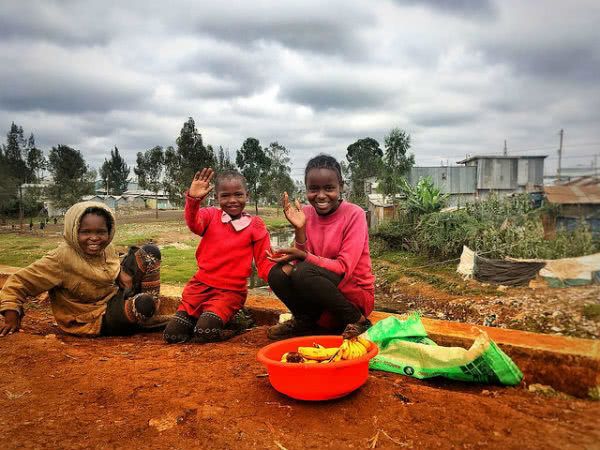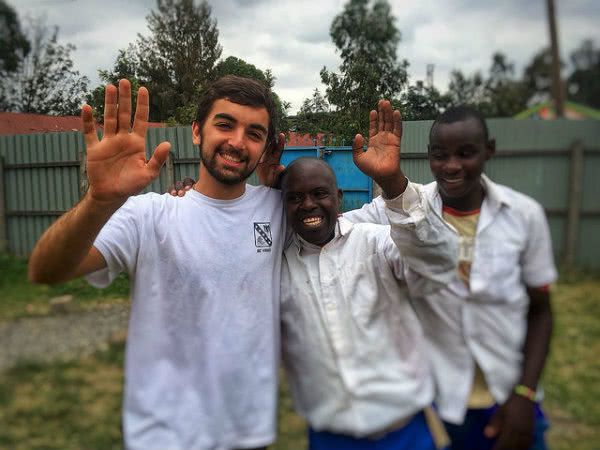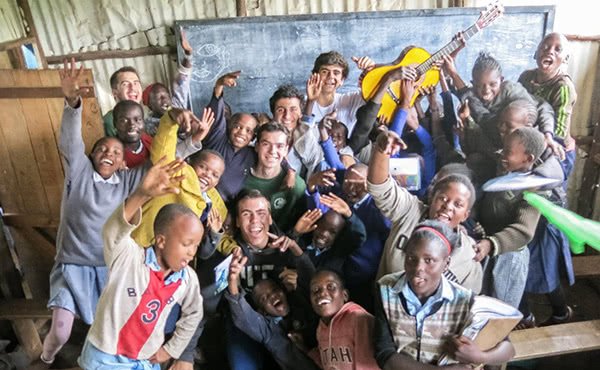They carried 60 bags of materials they wanted to distribute among the children. The bags were almost exploding as they were full to the brim with soccer balls, T shirts, soccer boots, frisbees, sports equipment, notebooks. They were students of Viaro, La Farga and Santa Isabel schools in Barcelona, who wanted to spend part of their summer holidays improving the material conditions of children and families living in the slums.
On arrival to Kenya the adventure began. A local person made their stay easier; he is called Moses Muthaka. He addressed each of us, always with a smile and with our names, in English, although he also speaks Swahili and Kikuyu. They got into a bus that Moses found through a friend of a friend … and got to the Eastlands College of Technology, where they stayed for a week. Together with other African students they worked with as a team making school desks

They divided themselves into six groups to assemble school tables for the slum schools, and to teach children, distribute food to the families so that they at least could have one meal a day. They were ready “to do whatever was needed”, says Joseph, who once he was back in Barcelona says that he is convinced that “until you experience volunteer work where you see many people surviving with very little, you are not aware of the needs existing in the world.” Robert, on the other hand, says that it was “a great experience because you were thanked tremendously for the little you gave to those children and families”. And he adds “ any complaint you may have had became absurd, and you realized the great luck you have of having been born in the place you have been born”.
Robert carries with him the memory of a boy lying on the ground with a huge headache because he had not eaten anything for some time. Joseph adds that “some children go to school because it is the only place where they can eat something.” He was surprised by the children’s generosity and cheerfulness. He explains that “one of the last days one of us had a biscuit which he gave to a 6 year old girl. The girl broke the biscuit and gave a piece to her younger brother and then broke the rest into small pieces which she gave to other children and she remained with nothing. She continued walking with a smile.”
Showing a way to the Sinai children
Moses accompanied them everywhere during their stay and helped them to understand the reality of the country. He has been working for a long time improving the conditions of poor families. Robert says that from the visits to the Sinai slum he learned that “it is advisable to know the families and children very well and give scholarships only to those who can make good use of them so that they can come out of poverty and later be able to help their families effectively.” Joseph explains that “many children grow up thinking that there is nothing better outside the slum accessible to them.” Education is the great tool and challenge.

They brought notebooks and school materials. Juan Miguel, a teacher, says that “you cannot imagine the joy of the children; when we finished distributing the material, two of the children’s teachers also asked us for notebooks because they didn’t have any either.” Joseph was also impressed “to see how the children wrote on their hands the mathematics calculations and in the notebooks only the answers so that the notebooks could last longer.”
Life in the slums
The image which was engraved in Robert’s mind was the one of “a father at the entrance to the slum with a serious face, clearly aware of his reality, and the children next to him smiling as this was the only reality they knew.” Borda, a teacher, says that “Kenyan children always come out to welcome you and know your names. They are not used to see white people (wazungu in swahili) there and are amazed and happy because we greeted them with a smile and had even learned some of their names.”
The houses are cubicles of 3 by 3 meters, where 5 to 6 people live, with no water or electricity. One of the teachers of those schools told us that they pay 10 euros a month as rent for a house which is next to a sewage line, but if the house has electricity they pay 20 euros. Moses told me that some of the Spanish students gave him, on their initiative, money so that some families could pay rent or for whatever they need.

Robert says that “it was worthwhile to spend a whole year preparing this trip raising money through concerts, sports competitions, dinners, and be bonded among ourselves in the process.” “We managed to make 100 tables for the schools, paint three classrooms in the Eastlands College and prepare the ground to install spot lights: mission accomplished,” says Juan Miguel. Next year, more.
On returning to Spain the group will share their experience with their classmates in the class after theirs to see whether they would want to continue with this initiative which started three years ago and would give them a much wider view of the world. They went to help, but the person who gives receives. Asante sana (Many thanks)
